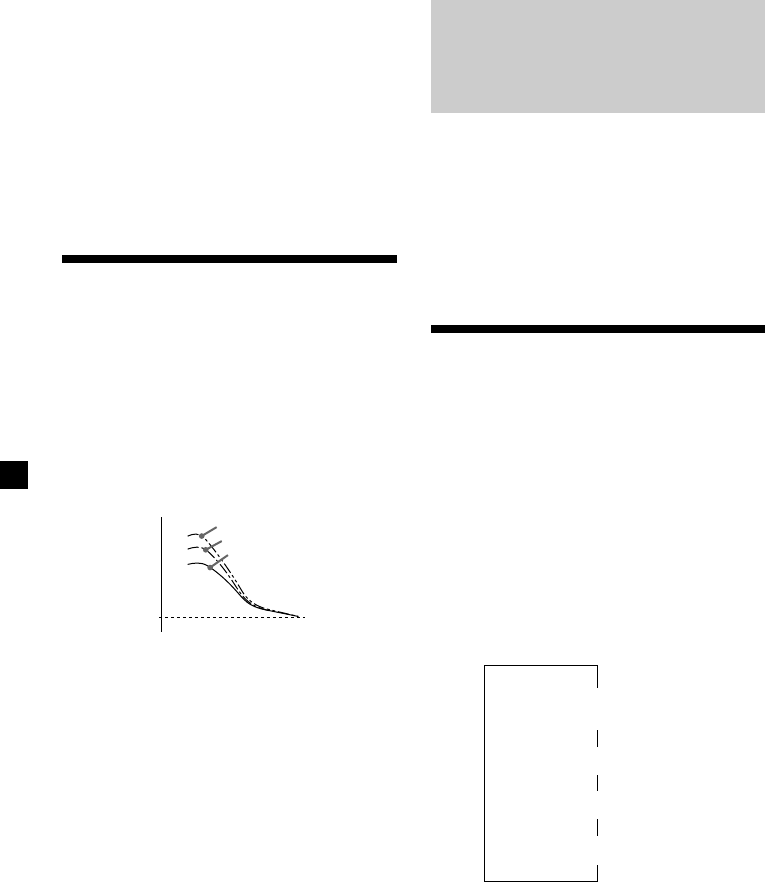User Guide
Table Of Contents
- Notes on MDs 4
- Getting Started
- Resetting the unit 7
- MD Player
- Radio
- Memorising stations automatically — Best Tuning Memory (BTM) 11
- RDS
- Other Functions
- Using the rotary commander 17
- CD/MD Unit
- Playing a CD or MD 20
- Additional Information
- Precautions 25
- 3/02-17_MDXC7970R.12SE.pdf
- Om MD-skivor 4
- Reglagens placering
- Komma igång
- Återställa enheten
- Ta bort frontpanelen
- Förbereda vridkontrollen
- Ställa klockan
- MD-spelare
- Lyssna på en MD-skiva
- Spela en MD-skiva i olika lägen
- Radio
- Lagra kanaler automatiskt — BTM-funktionen
- Lagra endast de önskade kanalerna
- Motta de lagrade kanalerna
- RDS
- Översikt av RDS-funktionen
- Visa kanalnamnet
- Ställa in samma program automatiskt — Alternativa frekvenser (AF)
- Lyssna på trafikmeddelanden
- Förinställa RDS-kanalerna med AF och TA data
- Söka en kanal efter programtyp
- Ställa klockan automatiskt
- Övriga funktioner
- Använda vridkontrollen
- Ljudjustering
- Snabbdämpa ljudet
- Ändra ljud- och teckeninställningarna
- Höja basljudet — D-bass
- CD/MD-spelare
- Spela en CD eller MD
- Spela upp spår flera gånger — Upprepad uppspelning
- Spela upp spår i slumpmässig ordning — Slumpmässig uppspelning
- Namnge en CD-skiva — Skivminne
- Hitta en CD-skiva efter namn — Lista namn
- Välja spår för uppspelning — Bank
- Ytterligare information
- Säkerhetsföreskrifter
- Underhåll
- Demontera enheten
- Tekniska data
- Felsökning
- 4/02-17_MDXC7970R.12PT.pdf
- Notas sobre os MD 4
- Localização das teclas 5
- Como começar
- Reinicializar o aparelho
- Retirar o painel frontal
- Preparar o comando rotativo
- Acertar o relógio
- Leitor de MDs
- Audição de um MD
- Reprodução de um MD em vários modos
- Rádio
- Memorização automática de estações — Memória da Melhor Sintonia (BTM)
- Memorização das estações pretendidas
- Recepção das estações memorizadas
- RDS
- Panorâmica da função RDS
- Visualização do nome da estação
- Resintonização automática do mesmo programa — Frequências Alternativas (AF)
- Ouvir informações sobre a situação do trânsito
- Pré-programação dos dados AF e TA nas estações RDS
- Localização de uma estação através do tipo de programa
- Acerto automático do relógio
- Outras funções
- Utilização do comando rotativo
- Regulação das características de som
- Redução do som ao mínimo
- Alteração das programações do visor e do som
- Intensificar o som dos graves — D-bass
- Dispositivo de CD/MD
- Reprodução de um CD ou MD
- Reprodução repetitiva das faixas — Reprodução Repetitiva
- Reprodução das faixas por ordem aleatória — Reprodução Aleatória
- Identificação de CD — Lista de títulos
- Localização de um disco pelo nome — Listagem
- Selecção de faixas específicas para reprodução — Banco
- Informação adicional
- Precauções
- Manutenção
- Desmontagem do aparelho
- Especificações
- Guia de resolução de problemas

20
With Optional Equipment
CD/MD Unit
This unit can control a maximum of seven
external CD/MD units in this configuration:
CD unit – maximum of five
MD unit – maximum of five.
Any combination up to seven will work.
If you connect an optional CD unit with the
CD TEXT function, the CD TEXT information
will appear in the display when you play back
a CD TEXT disc.
Playing a CD or MD
1 Press (SOURCE) repeatedly to select CD
or MD.
2 Press (MODE) until the desired unit
appears.
CD/MD playback starts.
When a CD/MD unit is connected, all the
tracks play from the beginning.
Changing the display item
Each time you press (DSPL) during CD, CD
TEXT, or MD playback, the item changes as
follows:
$
Track number/
Elapsed playback time
$
Disc name*
1
/Artist name*
2
$
Track name*
3
$
Clock
*
1
If you have not labelled the disc or if there is no
disc name prerecorded on the MD, “NO
D.Name” appears in the display.
*
2
If you play a CD TEXT disc, the artist name
appears in the display after the disc name. (Only
for CD TEXT discs with the artist name.)
*
3
If the track name of a CD TEXT disc or MD is not
prerecorded, “NO T.Name” appears in the
display.
3 Press (5) (n) to select the desired
setting (Example: on or off).
For the “Contrast” setting, pressing (5) (n)
makes the contrast higher, and pressing
(2) (N) makes the contrast lower.
4 Press (SHIFT).
After the mode setting is complete, the
display returns to normal playback mode.
Boosting the bass sound
— D-bass
You can enjoy a clear and powerful bass
sound.
The D-bass function boosts the low frequency
signal with a sharper curve than conventional
bass boost.
You can hear the bass line more clearly even
while the vocal volume remains the same. You
can emphasize and adjust the bass sound
easily with the D-BASS control.
Adjusting the bass curve
Turn the D-BASS control to adjust the
bass level (1, 2 or 3).
“D-BASS” appears in the display.
To cancel, turn the control to OFF.
Note
If the bass sound becomes distorted, adjust the
D-BASS control or volume control.
Level
Frequency (Hz)
0dB
D-BASS 3
D-BASS 2
D-BASS 1










